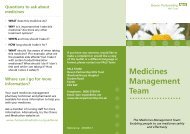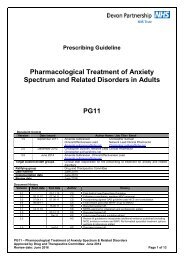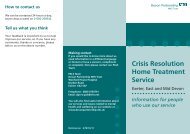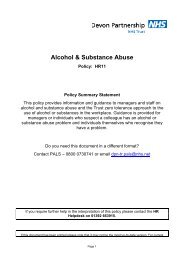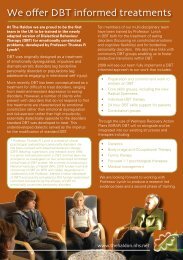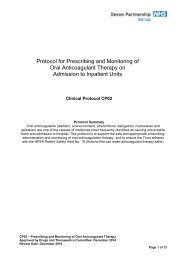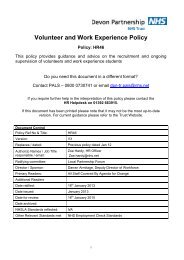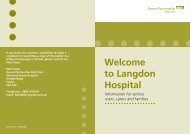CP01 Emergency Treatment of Anaphylactic Reactions - Devon ...
CP01 Emergency Treatment of Anaphylactic Reactions - Devon ...
CP01 Emergency Treatment of Anaphylactic Reactions - Devon ...
You also want an ePaper? Increase the reach of your titles
YUMPU automatically turns print PDFs into web optimized ePapers that Google loves.
Fig. 1<br />
A flow chart for the emergency treatment <strong>of</strong> an anaphylactic<br />
reaction (Appendix 1) will be located in the front pocket <strong>of</strong> the bag.<br />
The pack must be easily accessible in an emergency- under no<br />
circumstances will the pack be locked away in a drug cupboard or<br />
trolley.<br />
The ward manager / clinical team leader is responsible for ensuring<br />
that all clinical staff are aware <strong>of</strong> the agreed location <strong>of</strong> the<br />
Anaphylaxis Pack on their ward / unit and all new staff must be<br />
informed <strong>of</strong> this on their first day <strong>of</strong> employment.<br />
2.4 The Resuscitation Link Practitioner (or other designated registered nurse) will be<br />
responsible for checking and recording the expiry date <strong>of</strong> the emergency medication held on<br />
the ward and ensure the timely reordering <strong>of</strong> replacement stock.<br />
Good Practice Recommendation:<br />
Record the expiry date <strong>of</strong> all emergency medication held on the ward next to the medicine listed on<br />
the ward stock pr<strong>of</strong>ile (<strong>Emergency</strong> Medication section).<br />
The registered nurse completing the weekly medication stock order will check the expiry date on<br />
the pr<strong>of</strong>ile and re-order if the expiry date less than 2 weeks from the current date.<br />
2.5 <strong>Emergency</strong> medication will be re-ordered as necessary from the pharmacy department in<br />
accordance with Standard Operating Procedure MM27 (Ordering ward stock from pr<strong>of</strong>iles)<br />
3. Patient’s Own Medication (Adrenaline auto-injector devices)<br />
3.1 Auto-injectors devices (e.g. Epipen ® ) are prescribed on an individual basis, by a specialist in<br />
allergy, for self- administration by people who are at risk <strong>of</strong> an anaphylactic reaction.<br />
3.2 If a person on an inpatient unit experiences an anaphylactic reaction, intramuscular<br />
adrenaline (500micrograms) will be administered in accordance with this protocol (see<br />
section 2.1 and Appendix 1). However, if access to the emergency medication is delayed, it<br />
would be appropriate for a healthcare pr<strong>of</strong>essional to use the person’s own adrenaline autoinjector<br />
(NB this may deliver a dose <strong>of</strong> 300miccrograms or 500micrograms depending on the<br />
product prescribed), for the management <strong>of</strong> an anaphylactic reaction to ensure timely<br />
administration <strong>of</strong> treatment.<br />
3.3 For individuals prescribed an adrenaline auto-injector by a specialist or their GP, the product<br />
should be prescribed in the ‘when required’ section <strong>of</strong> the Trust inpatient prescription and<br />
administration chart to ensure clinicians are aware the person is prescribed, and usually<br />
carries, emergency medication for self- treatment <strong>of</strong> an anaphylactic reaction.<br />
3.4 Individuals prescribed an adrenaline auto-injector should carry this with them during periods<br />
<strong>of</strong> leave away from the unit and staff must also ensure that the person’s own adrenaline<br />
auto-injector device is returned to them at the time <strong>of</strong> discharge. (Refer to procedure MM08)<br />
4. Recognition and diagnosis <strong>of</strong> anaphylaxis<br />
4.1 When recognising (and treating) any acutely ill patient, a rational ABCDE approach must be<br />
followed (see 4.2) and life-threatening problems treated as they are recognised.<br />
4.2 A diagnosis <strong>of</strong> anaphylaxis is likely if a patient who is exposed to a trigger (allergen) also<br />
presents with the following;<br />
• Sudden onset and rapid progression <strong>of</strong> symptoms<br />
• Life-threatening Airway and/or Breathing and/or Circulation problems<br />
• Skin and/or mucosal changes (flushing, urticaria, angioedema)<br />
CP 01 - Protocol for the <strong>Emergency</strong> <strong>Treatment</strong> <strong>of</strong> <strong>Anaphylactic</strong> <strong>Reactions</strong><br />
Approved by Drugs and Therapeutics Committee: March 2014<br />
Review Date: March 2016 Page 4 <strong>of</strong> 8



